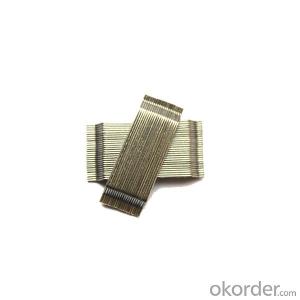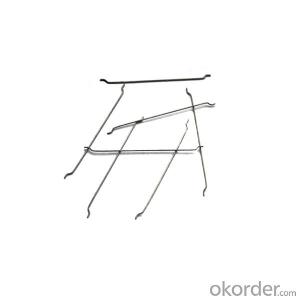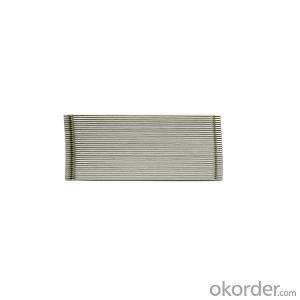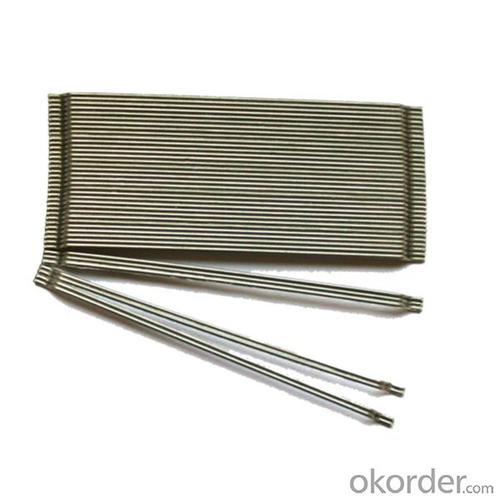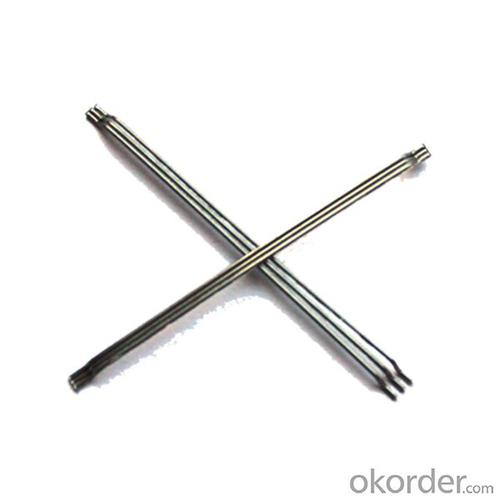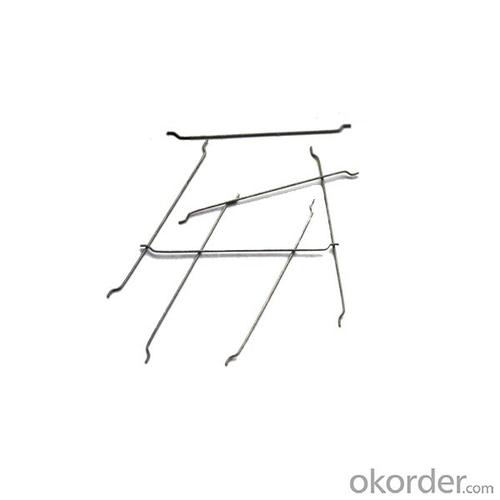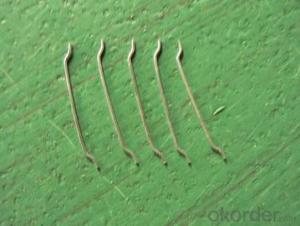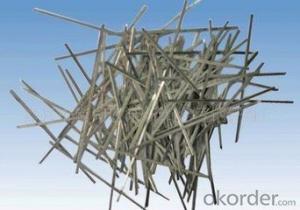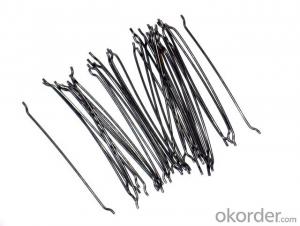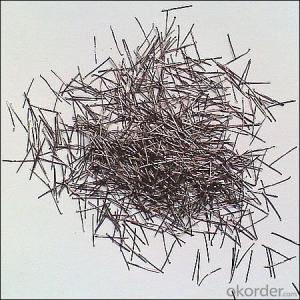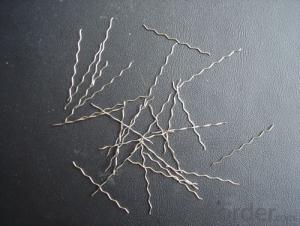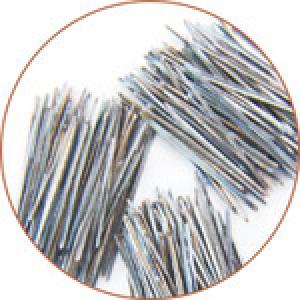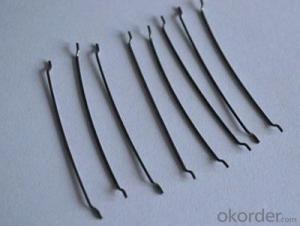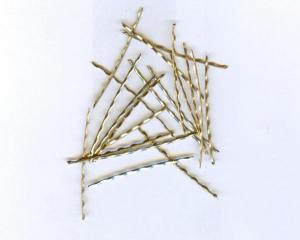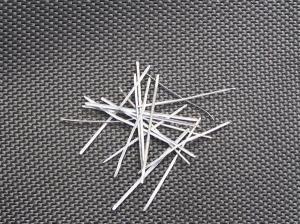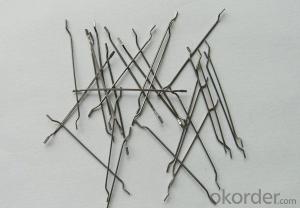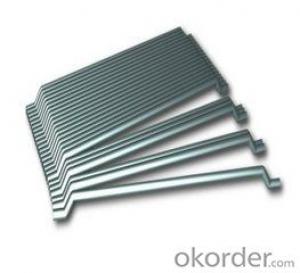Melt Extract Stainless Steel Fiber >1200MPA ASTM A820M-11 Type 1
- Loading Port:
- Tianjin
- Payment Terms:
- TT OR LC
- Min Order Qty:
- 20 m.t.
- Supply Capability:
- 600 m.t./month
OKorder Service Pledge
Quality Product, Order Online Tracking, Timely Delivery
OKorder Financial Service
Credit Rating, Credit Services, Credit Purchasing
You Might Also Like
Quick Details
Place of Origin: Tianjin, China (Mainland)
- Model Number: 0.75
Material: Steel
Production Process: Cold drawn
Fiber Lengh: 60
Type: 1
Compressive Strength: >1200MPa
Aspect ratio: 80
Standard: ASTM A820M-11
Section Shape: Circular
Application: Concrete Reinforcement
- Product Uses: Industrial flooring
Packaging & Delivery
| Packaging Details: | 20 kg/Bag,50 bags/Pallet or 1,000kg/ Bulk Bag |
|---|---|
| Delivery Detail: | 1 Month |
Product Description
| Diameter | 0.75 | mm | 0.03 | in |
| Length | 60.00 | mm | 2.35 | in |
| Aspect Ratio | 80 | |||
| Tensile strength | 1200 MPa | |||
| Type | Cold drawn Steel Fiber | |||
| End | Hooked-end Steel Fiber | |||
| Glued/Loose | Glued Steel Fiber | |||
| Bending Angle | 45°(min.30°) | |||
| Usage & Performance | Floor:Trafficked areas and Industrial floors | |||
| Shotcrete :Slope stabilization and Final lining | ||||
| Precast concrete:Pipe and Railway sleepers | ||||
| Packing | Standard Export Pallet Packing | Bag Packing | 20 kg/Bag,50 bags/Pallet | |
| Bulk Packing | 1,000kg/ Bulk Bag | |||
| Loading Quantity | 20’GP | 20-25 Tonne/Tonnes | ||
| 40’GP | 25-27 Tonne/Tonnes | |||
| 40’HQ | 25-27 Tonne/Tonnes | |||
| MOQ | 1 kg for trial order | |||
| Supply Ability | 10,000 Tonne/Tonnes per Year | |||
| Payment Terms | T/T or L/C at sight | |||
| Delivery Time | Within 15 days after receiving deposit or original L/C at sight | |||
| Certification | ISO9001:2000, CE, | |||
| Product | Diameter | Length mm/in | Aspect Ratio | Type | Packing |
| G-6030 | 0.5 mm (0.0197 in) | 30 mm (1.1811 in) | 60 | Glued | 20 kg/Bag, or 1,000kg/ Bulk Bag |
| G-6535 | 0.55 mm (0.0217 in) | 35 mm (1.3780 in) | 65 | Glued | 20 kg/Bag, or 1,000kg/ Bulk Bag |
| G-6035 | 0.6 mm (0.0236 in) | 35 mm (1.3780 in) | 60 | Glued | 20 kg/Bag, or 1,000kg/ Bulk Bag |
| G-8060 | 0.75 mm (0.0295 in) | 60 mm (2.3622 in) | 80 | Glued | 20 kg/Bag, 50 bags/Pallet |
| G-6060 | 0.9 mm (0.0354 in) | 60 mm (2.3622 in) | 60 | Glued | 20 kg/Bag, 50 bags/Pallet |
| G-6030 | 0.5 mm (0.0197 in) | 30 mm (1.1811 in) | 60 | Loose | 20 kg/Bag, or 1,000kg/ Bulk Bag |
| G-6535 | 0.55 mm (0.0217 in) | 35 mm (1.3780 in) | 65 | Loose | 20 kg/Bag, or 1,000kg/ Bulk Bag |
| G-6035 | 0.6 mm (0.0236 in) | 35 mm (1.3780 in) | 60 | Loose | 20 kg/Bag, or 1,000kg/ Bulk Bag |
| G-8060 | 0.75 mm (0.0295 in) | 60 mm (2.3622 in) | 80 | Loose | 20 kg/Bag, 50 bags/Pallet |
| G-6060 | 0.9 mm (0.0354 in) | 60 mm (2.3622 in) | 60 | Loose | 20 kg/Bag, 50 bags/Pallet |
- Q: Can melt extract stainless steel fiber be used in pre-stressed concrete elements?
- Yes, melt extract stainless steel fiber can be used in pre-stressed concrete elements. Melt extract stainless steel fibers are highly durable and provide excellent reinforcement properties to concrete structures. They can enhance the load-bearing capacity, crack resistance, and overall structural integrity of pre-stressed concrete elements. Additionally, the high tensile strength and corrosion resistance of stainless steel fibers make them ideal for use in environments where moisture or chemicals may be present. Overall, the use of melt extract stainless steel fibers in pre-stressed concrete elements can significantly improve the performance and longevity of the structure.
- Q: Can melt extract stainless steel fiber be used in high-temperature refractory applications?
- Indeed, high-temperature refractory applications can make use of melt extract stainless steel fiber. This fiber variant has been engineered to endure exceptionally hot temperatures and retain its structural soundness within environments characterized by intense heat. Its utilization is prevalent in refractory materials like castable refractories, ceramic fiber products, and other insulation applications pertaining to elevated temperatures. The outstanding features of melt extract stainless steel fiber encompass remarkable resistance to heat, corrosion, and mechanical stress, rendering it perfectly suitable for a diverse range of refractory applications that confront elevated temperatures.
- Q: The use and types of steel fibers
- Steel fiber, is to cut off the thin steel wire method, cold strip shearing, Ingot Milling or molten steel by rapid condensation growth ratio (ratio, fiber length and diameter when the fiber cross-section is not circular, the conversion of the equivalent section area of circle diameter) is 40 ~ 80 of the fiber.
- Q: What are the requirements for storage and handling of melt extract stainless steel fiber?
- The requirements for storage and handling of melt extract stainless steel fiber typically include keeping the fibers in a dry and clean environment to prevent corrosion. It is also important to store them away from any moisture or chemicals that could cause damage. Handling should be done with protective gloves to avoid any potential injury from the sharp edges of the fibers.
- Q: Can melt extract stainless steel fiber be used in the construction of wastewater treatment plants?
- Yes, melt extract stainless steel fiber can be used in the construction of wastewater treatment plants. Stainless steel fiber has excellent corrosion resistance properties, making it suitable for use in environments with high moisture and chemical exposure, such as wastewater treatment plants. It can be used in various applications within the plant, including reinforcing concrete structures, providing additional strength and durability. The stainless steel fiber's resistance to corrosion ensures its longevity and reduces the risk of degradation over time. Additionally, the fiber's high tensile strength and ability to withstand extreme temperatures make it a reliable choice for use in wastewater treatment plants.
- Q: Can melt extract stainless steel fiber improve the resistance of concrete to fire?
- Certainly, the incorporation of melt extract stainless steel fiber into concrete has the ability to enhance its fire resistance. Renowned for their elevated melting point, resistance to corrosion, and exceptional heat conductivity, stainless steel fibers are an optimal choice for bolstering the fire resistance of concrete. Upon their addition to concrete, these fibers establish a three-dimensional reinforcement network, effectively preventing the occurrence of cracks and spalling during exposure to fire. Furthermore, the stainless steel fibers serve as a heat sink, proficiently absorbing and dissipating heat, thus significantly impeding the rise in temperature within the concrete and consequently augmenting its fire resistance. Moreover, these fibers fortify the concrete's overall strength and durability, rendering it more resilient to fire and extending its structural integrity even under extreme temperatures. Consequently, the inclusion of melt extract stainless steel fiber in concrete unquestionably improves its resistance to fire.
- Q: Does melt extract stainless steel fiber improve the resistance to spalling of concrete?
- Concrete spalling is effectively reduced by the inclusion of melt extract stainless steel fiber. Spalling occurs when the outer layer of concrete chips or flakes away due to factors like freeze-thaw cycles, high temperatures, or chemical attacks. The incorporation of melt extract stainless steel fibers in the concrete mixture reinforces it, providing an extra layer of strength, and preventing spalling. The stainless steel fibers are well-dispersed throughout the concrete matrix, enhancing its overall tensile strength. When the concrete is subjected to stress, like during freeze-thaw cycles or high temperatures, the fibers help to evenly distribute the forces and prevent crack propagation. This reinforcement mechanism significantly decreases the likelihood of spalling, as the stainless steel fibers create a barrier that safeguards the surface layer from chipping off. Moreover, melt extract stainless steel fibers also enhance the durability and lifespan of the concrete. These fibers enhance its resistance to corrosion, which is a common cause of spalling in concrete exposed to harsh environments or chemical attacks. By providing a protective layer against corrosion, the stainless steel fibers ensure that the concrete maintains its structural integrity and remains resilient against spalling for an extended period. In summary, the inclusion of melt extract stainless steel fiber in concrete effectively improves its resistance to spalling. These fibers act as reinforcement, evenly distributing stress and preventing crack propagation, while also enhancing the concrete's durability and corrosion resistance.
- Q: Can melt extract stainless steel fiber be added to cementitious grouts?
- Yes, melt extract stainless steel fiber can be added to cementitious grouts. Stainless steel fibers are commonly used as a reinforcement material to enhance the mechanical properties of cementitious products. When added to grouts, stainless steel fibers can improve the tensile strength, flexural strength, and crack resistance of the grout. The addition of stainless steel fibers also helps to control shrinkage and prevent cracking. Overall, incorporating melt extract stainless steel fibers into cementitious grouts can enhance their performance and durability.
- Q: Does melt extract stainless steel fiber improve the fatigue resistance of concrete?
- Yes, melt extract stainless steel fiber can improve the fatigue resistance of concrete. Stainless steel fibers are known for their high tensile strength and excellent corrosion resistance properties. When added to concrete, these fibers act as reinforcement and help to distribute stress more evenly throughout the material, reducing the likelihood of cracking and failure under cyclic loading conditions. The addition of melt extract stainless steel fiber to concrete can significantly enhance the fatigue resistance of the material. The fibers help to absorb and dissipate energy during loading and unloading cycles, thereby reducing the accumulation of microcracks and increasing the overall durability of the concrete. This improved fatigue resistance is particularly beneficial in structures subjected to repetitive or dynamic loading, such as bridges, pavements, and industrial floors. Furthermore, melt extract stainless steel fibers have a high aspect ratio, meaning they have a relatively large length compared to their diameter. This aspect ratio allows the fibers to effectively bridge across cracks that may occur in the concrete, preventing their propagation and enhancing the overall structural integrity of the material. In summary, the addition of melt extract stainless steel fiber to concrete can greatly improve its fatigue resistance by enhancing its ability to withstand cyclic loading. This reinforcement helps to prevent crack formation and propagation, resulting in a more durable and long-lasting concrete structure.
- Q: What is the effect of melt extract stainless steel fiber on the flexural strength of shotcrete?
- The addition of melt extract stainless steel fiber to shotcrete has a significant positive effect on its flexural strength. Shotcrete is a construction material that is commonly used for building and repair projects. It is a mixture of cement, sand, and water that is sprayed onto a surface using a high-pressure hose. Shotcrete is known for its high strength and durability, but it can still be prone to cracking and reduced flexural strength. By incorporating melt extract stainless steel fiber into the shotcrete mix, the flexural strength of the material is greatly improved. Stainless steel fibers are highly durable and have excellent tensile strength, which helps to reinforce the shotcrete and prevent cracking. The addition of these fibers increases the overall toughness and ductility of the shotcrete, allowing it to better withstand external forces and stresses. This is particularly beneficial in applications where the shotcrete is exposed to high load conditions or where the structure needs to have increased resistance to cracking. Furthermore, the melt extract stainless steel fibers help to reduce the formation and propagation of cracks within the shotcrete matrix. These fibers act as tiny reinforcement elements that bridge across cracks, preventing them from expanding and spreading. This helps to maintain the integrity of the shotcrete and prolong its service life. Overall, the effect of melt extract stainless steel fiber on the flexural strength of shotcrete is highly positive. It enhances the material's ability to resist cracking, increases its toughness and ductility, and improves its overall durability. This makes shotcrete with stainless steel fiber reinforcement an excellent choice for a wide range of construction and repair projects.
Send your message to us
Melt Extract Stainless Steel Fiber >1200MPA ASTM A820M-11 Type 1
- Loading Port:
- Tianjin
- Payment Terms:
- TT OR LC
- Min Order Qty:
- 20 m.t.
- Supply Capability:
- 600 m.t./month
OKorder Service Pledge
Quality Product, Order Online Tracking, Timely Delivery
OKorder Financial Service
Credit Rating, Credit Services, Credit Purchasing
Similar products
Hot products
Hot Searches
Related keywords

